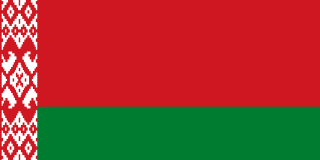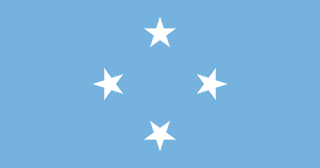
The national flag of the United States, often referred to as the American flag or the U.S. flag, consists of thirteen equal horizontal stripes of red alternating with white, with a blue rectangle in the canton, referred to as the union and bearing fifty small, white, five-pointed stars arranged in nine offset horizontal rows, where rows of six stars alternate with rows of five stars. The 50 stars on the flag represent the 50 U.S. states, and the 13 stripes represent the thirteen British colonies that declared independence from Great Britain, which they obtained in their victory in the American Revolutionary War.

Palau, officially the Republic of Palau, is an island country in the Micronesia subregion of Oceania in the western Pacific. The republic consists of approximately 340 islands and connects the western chain of the Caroline Islands with parts of the Federated States of Micronesia. It has a total area of 466 square kilometers (180 sq mi), making it one of the smallest countries in the world. The most populous island is Koror, home to the country's most populous city of the same name. The capital Ngerulmud is located on the largest island of Babeldaob, in Melekeok State. Palau shares maritime boundaries with international waters to the north, the Federated States of Micronesia to the east, Indonesia to the south, and the Philippines to the northwest.

Koror is the state comprising the main commercial centre of the Republic of Palau. It consists of several islands, the most prominent being Koror Island. It is Palau’s most populous state.

The flag of the state of Oregon is a two-sided flag in navy blue and gold with an optional gold fringe. On the front is the escutcheon from the state seal and on the reverse is a gold figure of a beaver, the state animal. Oregon is the only U.S. State to feature different designs on either side of its flag.

The flag of the Republic of China, commonly called the flag of Taiwan, consists of a red field with a blue canton bearing a white disk surrounded by twelve triangles; said symbols symbolize the sun and rays of light emanating from it, respectively.

The national flag of Brazil, is a blue disc depicting a starry sky spanned by a curved band inscribed with the national motto "Ordem e Progresso", within a yellow rhombus, on a green field. It was officially adopted on 19 November 1889 — four days after the Proclamation of the Republic, to replace the flag of the Empire of Brazil. The concept was the work of Raimundo Teixeira Mendes, with the collaboration of Miguel Lemos, Manuel Pereira Reis and Décio Villares.

The flag of the state of North Carolina, often referred to as the North Carolina flag, N.C. flag, or North Star, is the state flag of the U.S. state of North Carolina.

The Bear Flag is the official flag of the U.S. state of California. The precursor of the flag was first flown during the 1846 Bear Flag Revolt and was also known as the Bear Flag. A predecessor, called the Lone Star Flag, was used in an 1836 independence movement; the red star element from that flag appears in the Bear Flag of today.

The national flag of Libya was originally introduced in 1951, following the creation of the Kingdom of Libya. It was designed by Omar Faiek Shennib and approved by King Idris Al Senussi who comprised the UN delegation representing the three regions of Cyrenaica, Fezzan, and Tripolitania at UN unification discussions.

The national flag of Bangladesh was adopted officially on 17 January 1972. It consists of a red disc or sun on top of a dark green banner. The red disc is offset slightly toward the hoist so that it appears centered when the flag is flying. While there are many interpretations, according to Shib Narayan Das who put the map on the first flag design, green on the flag represented the landscape and the red circle represented the sun, symbolising a new day and end of oppression.

The State flag of Belarus is a red-green bicolour with a red-on-white ornament pattern placed at the hoist (staff) end. The current design was introduced in 2012 by the State Committee for Standardisation of the Republic of Belarus, and is adapted from a design approved in a May 1995 referendum. It is a modification of the 1951 flag used while the country was a republic of the Soviet Union. Changes made to the Soviet-era flag were the removal of communist symbols – the hammer and sickle and the red star – as well as the reversal of the colours in the ornament pattern. Since the 1995 referendum, several flags used by Belarusian government officials and agencies have been modelled on this national flag.

The flag of the Federated States of Micronesia was adopted on 30 November 1978. The blue field represents the Pacific Ocean. In an echo of U.S. heraldic practice, the stars represent the four federated states: Chuuk, Pohnpei, Kosrae and Yap, arranged like the points of the compass.

The Flag of Palau was adopted on 1 January 1981, when the island group separated from the United Nations Trust Territory. As with the flags of several other Pacific island groups, light blue is the color used to represent the ocean and the nation's place within it. While this puts Palau in common with the Federated States of Micronesia and other neighboring island groups, the disc on the flag is off-centre like that of the flag of Bangladesh, but in this case the disc represents the moon instead of the sun. The current flag was introduced in 1981 when Palau became a republic.

The current flag of Indiana was designed by Paul Hadley and officially adopted by the State of Indiana in May 1917. It is the state's second official flag and has remained unchanged since then except for the creation of a statute to standardize the production of the flag in 1955.

The Great Seal of Missouri is used to authenticate certain documents issued by the Government of Missouri. The phrase is used both for the physical seal itself, which is kept by the secretary of state, and more generally for the design impressed upon it. The Great Seal was designed by Robert Wells of Jefferson City.

The flag of Pittsburgh is a triband flag featuring vertical bands of black and gold and Pittsburgh's coat of arms in the center.
There is a small Japanese community in the Pacific Island country of Palau, which mainly consists of Japanese expatriates residing in Palau over a long-term basis. A few Japanese expatriates started to reside in Palau after it gained independence in 1994, and established long-term businesses in the country. Japanese settlement in Palau dates back to the early 19th century, although large scale Japanese migration to Palau did not occur until the 1920s, when Palau came under Japanese rule and administered as part of the South Seas Mandate. Japanese settlers took on leading administrative roles in the Japanese colonial government, and developed Palau's economy. After the Japanese surrender in 1945, virtually all of the Japanese population was repatriated back to Japan, although people of mixed Japanese-Palauan descent were allowed to remain behind. People of Japanese-Palauan descent constitute a large minority of Palau's population as a result of substantial intermarriage between the Japanese settlers and Palauans. They generally identify with, conforming to cultural norms and daily lives with the Palauans.

Koror City is the largest city and the commercial center in Palau, home to about half of the country's population, located on Oreor Island. During the interwar period it served as the capital of the South Seas Mandate, a group of islands that made up the League of Nations mandated territory held by the Empire of Japan. It was subsequently the capital of Palau until it was replaced by Ngerulmud in 2006.
The flag of Earth is a concept of a possible flag design meant to symbolize the planet Earth, humankind, or a possible world government.
















